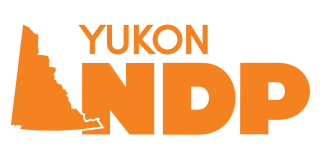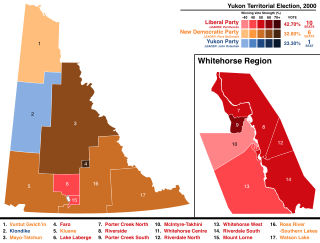Related Research Articles

Events from the year 1905 in Canada.

The Yukon New Democratic Party is a social democratic political party in the Yukon, Canada. It is the provincial section of the federal New Democratic Party.

The Yukon Party, formerly the Yukon Progressive Conservative Party is a conservative political party in Yukon, Canada.

The 2000 Yukon general election was held on April 17, 2000 to elect members of the 30th Yukon Legislative Assembly in the Yukon Territory in Canada. The incumbent NDP government was defeated by the Liberal Party, which formed a majority government.

Northwest Territories is a federal electoral district represented in the House of Commons of Canada. The electoral district covers the entire territory.

James Hamilton Ross was a Canadian politician, the third commissioner of Yukon, and an ardent defender of territorial rights. He is also considered to be the first resident of Moose Jaw, Saskatchewan.

Klondike is an electoral district which returns a member to the Legislative Assembly of Yukon in Canada. One of Yukon's eight rural ridings, it is also the oldest riding in Yukon, first established in 1905. The riding includes Dawson City and its environs, as well as Eagle Plains.
The 1915 Yukon general election was held on March 4 to elect the ten members of the Yukon Territorial Council. The members were chosen from five different electoral districts with the two most popular winning seats Plurality block voting.
The 1952 Yukon general election was held on 20 August 1952 to elect the five members of the Yukon Territorial Council. The council was non-partisan, and worked on the basis of consensus government.
The 1955 Yukon general election was held on 28 September 1955 to elect the five members of the Yukon Territorial Council. The council was non-partisan and had merely an advisory role to the federally appointed Commissioner.
The 1958 Yukon general election was held on 8 September 1958 to elect the five members of the Yukon Territorial Council. The council was non-partisan and had merely an advisory role to the federally appointed Commissioner.
The 1907 Yukon general election was held on 16 April 1907 to elect five of the ten members of the Yukon Territorial Council.
The 1903 Yukon general election was held on January 13, 1903. The council was expanded to elect five of the ten members to the Yukon Territorial Council. The election was fought along party lines even though the council was limited in its powers and played an advisory role to the federally appointed Commissioner.
The Yukon Territorial Council was a political body in the Canadian territory of Yukon, prior to the creation of the Yukon Legislative Assembly. Although not a full legislature, the council acted as an advisory body to the Commissioner of Yukon, and had the power to pass non-binding motions of legislation which would be forwarded to the commissioner for consideration.
The Diocese of Yukon is a diocese of the Ecclesiastical Province of British Columbia and Yukon of the Anglican Church of Canada. It comprises 13 parishes across the Yukon and parts of northern British Columbia.
Bonanza was a territorial electoral district in the Canadian territory of Yukon, which returned one or two members to the Yukon Territorial Council from 1905 to 1920.
North Dawson was a territorial electoral district in the Canadian territory of Yukon, which returned one or two members to the Yukon Territorial Council from 1905 to 1920.
South Dawson was a territorial electoral district in the Canadian territory of Yukon, which returned one or two members to the Yukon Territorial Council from 1905 to 1920.
References
- ↑ Steven Smyth, The Yukon's Constitutional Foundations: Volume One, The Yukon Chronology (1897-1999). Clairedge Press, 1999.
- ↑ "Yukon Election Result: H. C. Macaulay, T. W. O'Brien and Richard Gillespie Successful in Contested Districts — Joe Clarke Goes Down to Defeat". Whitehorse Star , April 13, 1905.